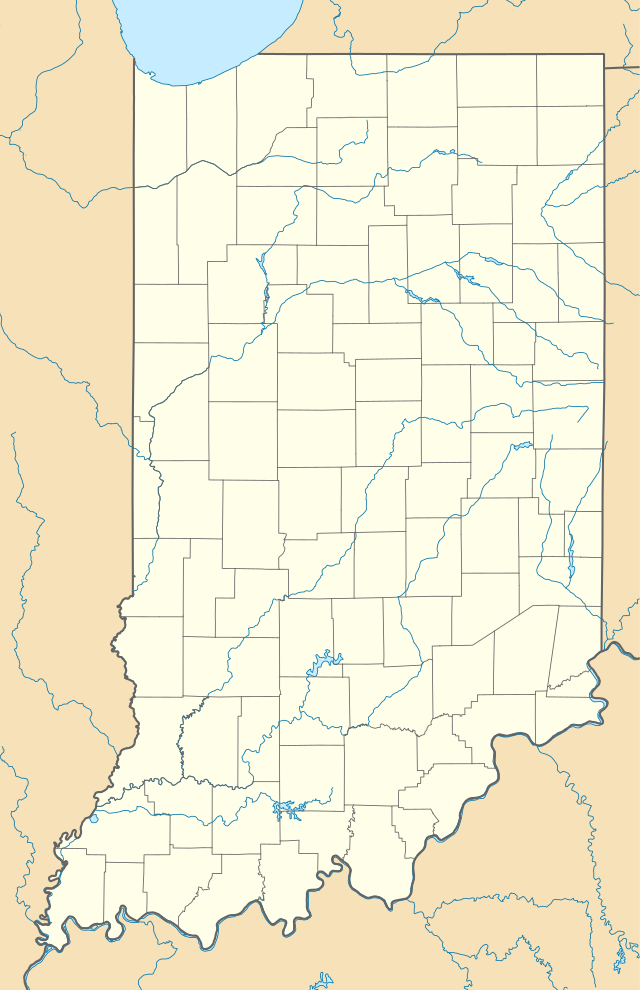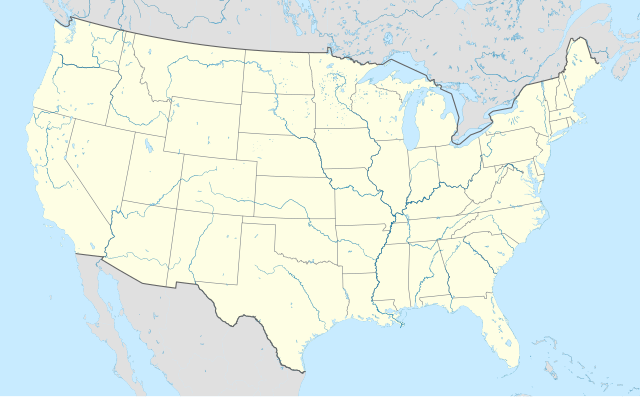Pennsylvania_Railroad_Station_(Fort_Wayne,_Indiana)
Fort Wayne station
Historic train station in Fort Wayne, Indiana, U.S.
The Pennsylvania Railroad Station in Fort Wayne, Indiana, also known as Baker Street Station, is a former passenger rail station in downtown Fort Wayne, Indiana. The American Craftsman-style station opened to the public March 23, 1914, at a cost of $550,000.[3][4]
Fort Wayne, IN | |||||||||||||||||||||||||||||||||||||||||||||
|---|---|---|---|---|---|---|---|---|---|---|---|---|---|---|---|---|---|---|---|---|---|---|---|---|---|---|---|---|---|---|---|---|---|---|---|---|---|---|---|---|---|---|---|---|---|
 Passengers board Amtrak's Broadway Limited at the station in 1974 | |||||||||||||||||||||||||||||||||||||||||||||
| General information | |||||||||||||||||||||||||||||||||||||||||||||
| Location | 221 Baker Street, Fort Wayne, Indiana USA | ||||||||||||||||||||||||||||||||||||||||||||
| History | |||||||||||||||||||||||||||||||||||||||||||||
| Opened | March 23, 1914 | ||||||||||||||||||||||||||||||||||||||||||||
| Closed | November 11, 1990[1] | ||||||||||||||||||||||||||||||||||||||||||||
| Former services | |||||||||||||||||||||||||||||||||||||||||||||
| |||||||||||||||||||||||||||||||||||||||||||||
Pennsylvania Railroad Station | |||||||||||||||||||||||||||||||||||||||||||||
 | |||||||||||||||||||||||||||||||||||||||||||||
| Location | 221 West Baker Street, Fort Wayne, Indiana | ||||||||||||||||||||||||||||||||||||||||||||
| Coordinates | 41°4′20″N 85°8′26″W | ||||||||||||||||||||||||||||||||||||||||||||
| Built | 1914 | ||||||||||||||||||||||||||||||||||||||||||||
| Architect | George B. Swift & Co., William L. Price | ||||||||||||||||||||||||||||||||||||||||||||
| Architectural style | American Craftsman | ||||||||||||||||||||||||||||||||||||||||||||
| NRHP reference No. | 98001056[2] | ||||||||||||||||||||||||||||||||||||||||||||
| Added to NRHP | 1998 | ||||||||||||||||||||||||||||||||||||||||||||
The station saw its most heavy usage during World War II, when about 3,000 visitors passed through the station daily.[3] The station was also frequented by politicians on whistle stop train tours, including U.S. Presidents Harding, Coolidge, Hoover, Franklin D. Roosevelt, Truman, and Eisenhower.[3] Until 1957 a Grand Rapids originating branch of the Pennsylvania Railroad's Chicago-Florida Southland made a stop in at the station, and picked up passengers from a connecting Wabash Railroad train from Detroit, Michigan.[5][6] Until 1961 the PRR's Cincinnati, Ohio-Mackinaw City, Michigan Northern Arrow also made a stop there, and picked up connecting passenger rail cars from Chicago.[7] Until 1971 the Penn Central ran the Broadway Limited and several other Chicago-New York City passenger trains, Admiral, Manhattan Limited and Pennsylvania Limited through the station.[8]
In the second half of the 20th century, the station served as a stop on Amtrak's Broadway Limited (Chicago—Pittsburgh—New York) and Capitol Limited (Chicago–Pittsburgh–Washington) lines until November 1990 when Amtrak was forced to reroute about 25 miles (40 km) north of Fort Wayne.[9] The nearest active passenger train station is Waterloo (for the Capitol Limited), 32 miles to the north.
Today, Baker Street Station's concourse is used as a banquet hall and community events space,[10] while the east and west wings have been converted into office space.[3] Over the last decade, residents and local leaders have begun a movement to bring passenger rail service back to the city and station in the form of Amtrak or other high-speed rail service.[11]
Although the station has been without passenger rail service for over 30 years, it has remained a landmark to the city, designated a Fort Wayne Local Historic District in 1990.[12] and later, was added to the National Register of Historic Places in 1998 as the Pennsylvania Railroad Station.[2]
- "Amtrak Switches Lines to Chicago". Pittsburgh Post-Gazette. November 12, 1990. p. 10. Retrieved January 12, 2019 – via Newspapers.com.

- "Indiana, Allen County". National Register of Historic Places. Retrieved 2013-06-18.
- "Indiana State Historic Architectural and Archaeological Research Database (SHAARD)" (Searchable database). Department of Natural Resources, Division of Historic Preservation and Archaeology. Retrieved 2015-07-01. Note: This includes Creager Smith (July 1997). "National Register of Historic Places Inventory Nomination Form: Pennsylvania Railroad Station" (PDF). Retrieved 2015-07-01. and Accompanying photographs
- Pennsylvania Railroad August 1950 timetable, Table C
- Louisville and Nashville December 1948, Table E
- Pennsylvania Railroad August 1950 timetable, Table 22
- Kanary, George E. (June 2011). "Things Were Not the Same After May 1, 1971" (PDF). First and Fastest. p. 19. Archived from the original (PDF) on August 13, 2016.
- Sanders (2006), 24–25.
- "Banquet Facility". Baker Street Train Station. Retrieved 2013-06-18.
- Caylor, Bob (2009-04-04). "Rally for Fort Wayne train service draws hundreds". The News-Sentinel. Archived from the original on 2009-04-18. Retrieved 2013-06-18.
- "Fort Wayne Local Historic Districts". Architecture and Community Heritage (ARCH). Archived from the original on 2013-06-24. Retrieved 2013-06-18.
 Media related to Pennsylvania Railroad Station (Fort Wayne, Indiana) at Wikimedia Commons
Media related to Pennsylvania Railroad Station (Fort Wayne, Indiana) at Wikimedia Commons- Baker Street Station
This article about a property in Allen County, Indiana on the National Register of Historic Places is a stub. You can help Wikipedia by expanding it. |

